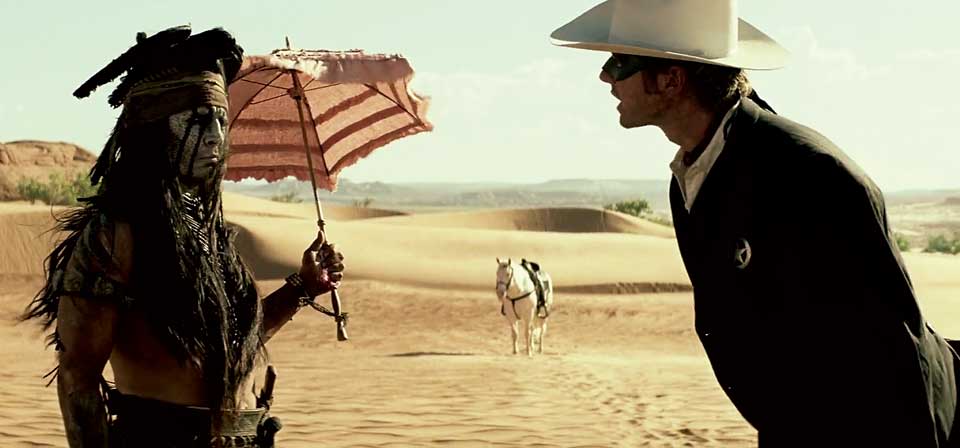Tags :: Indigenous Peoples

Violence and virtue: How Christian is The Revenant?
Whether one sees The Revenant as a spiritually rich, profound meditation on good and evil or an overwrought attempt to transmogrify atrocity into transcendence, Christians should recognize that when it comes to media depictions of violence, there are two potential dangers, not just one.

The Lone Ranger (2013)
Even more than Man of Steel, The Lone Ranger is the poster child for our culture’s terminal inability to offer children today heroic role models … I’ve seen many movies that were objectively worse than The Lone Ranger. Very few have made me angrier.
Apocalypto (2006)
Gibson is a consummate filmmaker, and the action is never less than riveting. Yet as the film repeatedly ratchets up the wince factor beyond what seems necessary or appropriate, it’s hard not to feel that suffering has been reduced to spectacle.
The New World (2006)
Up to a point, there is a level of artistic kinship between The New World, Terence Malick’s dreamlike origin myth of the American colonies, and another recent, visually poetic meditation on a foundation story: Mel Gibson’s The Passion of the Christ.
King Solomon’s Mines (1950)
Recent knock-offs have been especially lame: A 2004 Hallmark Channel version starring Patrick Swayze shows some initial promise before losing its way in the second act amid boring plot twists and PC alternative spirituality (lots of talk about “having faith in the ancestors,” and the evil, ancient witch Gagool is reinvented as a benevolent young shamaness!). About Sean Connery’s recent turn as Haggard hero Alan Quatermain in the almost completely inspiration-free League of Extraordinary Gentlemen, not to mention the 1985 version, a campy Raiders of the Lost Ark wannabe starring Sharon Stone, the less said, the better.
King Solomon’s Mines (1937)
Lewis would have been left equally cold to subsequent screen versions of Haggard’s story, all of which give Haggard hero Allan Quatermain a female foil (who is always, except here, a love interest), and none of which capture the deathly spell of the mountain tomb (though the classic 1950 version is the least objectionable on this point).
The Searchers (1956)
The reputation of John Ford’s The Searchers as a classic but troubling Western in which John Wayne plays an Indian-hating racist is so widely accepted that it’s a bit of a surprise to discover that the film, and the character, are in fact more complex than the reputation suggests.
The Missing (2003)
In place of Ford’s iconic but Indian-hating cowboy hero, Howard gives us two white protagonists who are each, in their own ways, the antitheses of the John Wayne character.
Animals are Beautiful People (1975)
Highlights include daredevil cartwheeling baboons, the remarkable partnership of the badger and the honey-guide bird, and the astonishingly intricate lengths to which the Kalahari bushmen go to find water. There’s a sequence with the animal residents of the fertile Kavango flood plains intoxicated on fermented fruit, and footage of an ostrich mating dance that strikingly resembles Fantasia’s animated ostrich ballet.
The Four Feathers (2002)
Monte Cristo is also the only one of the three that knows it’s essentially a comic-book movie, and has appropriately modest aspirations. Like Road to Perdition, The Four Feathers feels like a weighty epic, though neither movie weighs in at more than about two hours, and neither really knows what it’s about.
Spirit: Stallion of the Cimarron (2002)
A strangely grim indoctrination into the politics of victimization, Spirit apparently expects kids to slog willingly through scene after scene of this stuff, not because it’s all such fun to watch, but because the filmmakers are so sure it’s Good For You.
The Mission (1986)
From the unforgettable opening sequence, with its stunning depiction of the martyrdom of a silent Jesuit missionary at the hands of equally silent South American natives, the film is shot through with piercing, haunting imagery, pictures of enduring imaginative force.
Recent
- Benoit Blanc goes to church: Mysteries and faith in Wake Up Dead Man
- Are there too many Jesus movies?
- Antidote to the digital revolution: Carlo Acutis: Roadmap to Reality
- “Not I, But God”: Interview with Carlo Acutis: Roadmap to Reality director Tim Moriarty
- Gunn’s Superman is silly and sincere, and that’s good. It could be smarter.
Home Video
Copyright © 2000– Steven D. Greydanus. All rights reserved.